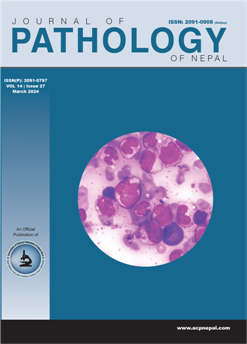Histopathological study of scaly plaque over palm and sole in patients attending a tertiary care Hospital in Kathmandu
DOI:
https://doi.org/10.3126/jpn.v14i1.66378Keywords:
Dermatitis, eczema, psoriasis, palm, sole, scaly plaqueAbstract
Background: Dermatoses of palms and soles are frequently encountered as palms and soles have non-hairy skin. Scaling skin could be a symptom of many medical conditions including psoriasis, eczema, contact dermatitis, ichthyosis, actinic keratosis, lichen planus, tinea, etc. Psoriasis must be differentiated from its non-psoriatic lesions. Histopathological examination often serves as a confirmative part of the diagnosis.
Materials and methods: This was a hospital-based retrospective study carried out in the Department of Pathology and Department of Dermatology of Nepal Medical College Teaching Hospital. A total of 139 cases of scaly plaque skin lesions of the palm and sole from January 2020 to December 2022 were included in the study. The histopathological diagnosis was correlated with the clinical diagnosis.
Results: Among 139 persons presenting with scaly lesions, the median age was 36 years with an age range from 15 years to 80 years. A female preponderance (59%) was observed. The odds of Psoriasis were 2.5 times higher (OR CI: 1.21 to 5.17) among those aged 36 years and above (P value 0.011). There was a significant association between age categories and histological diagnosis of scaly lesions. The agreement was significant between the clinical and histological diagnosis for psoriatic (63.0%) and non-psoriatic lesions (76.3%) with a Cohen’s kappa coefficient of 0.38 (SE: 0.084), P value < 0.0001.
Conclusions: Both psoriatic and non-psoriatic lesions can present as scaly plaque skin lesions, hence the knowledge of these clinical mimickers is important for the proper diagnosis. The histopathological examination will give the confirmatory diagnosis.
Downloads
Downloads
Published
How to Cite
Issue
Section
License
Copyright (c) 2024 The Author(s)

This work is licensed under a Creative Commons Attribution 4.0 International License.
This license enables reusers to distribute, remix, adapt, and build upon the material in any medium or format, so long as attribution is given to the creator. The license allows for commercial use.




